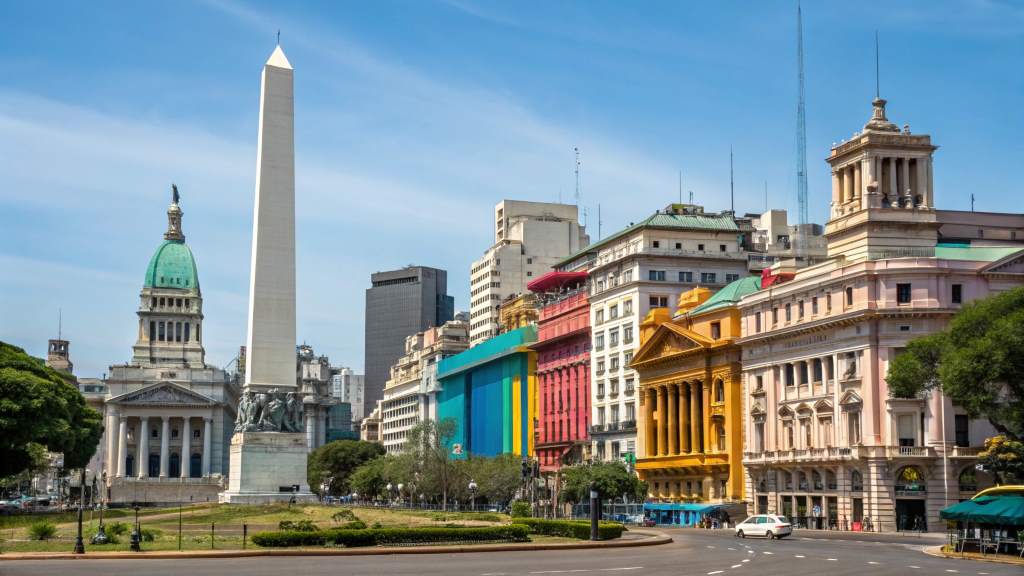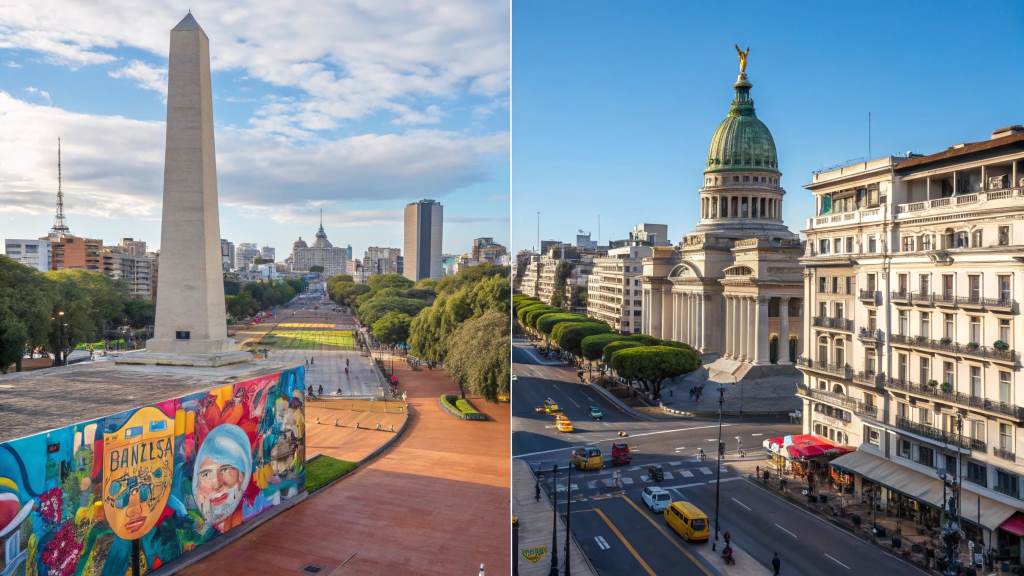
Buenos Aires is a city that pulses with life, culture, and history. Known as the “Paris of South America,” it blends European elegance with Latin American passion. Visitors can explore grand boulevards, historic neighborhoods, world-class museums, and tango-filled streets. The food scene is rich with Argentine steak, empanadas, and fine wines. Whether you’re a history lover, foodie, or adventure seeker, Buenos Aires has something for you.
This guide covers what to see in Buenos Aires, from famous landmarks to local secrets.
1. Plaza de Mayo: The Heart of Buenos Aires
Plaza de Mayo is the city’s political and historical epicenter. Since the 19th century, it has been a gathering place for protests and celebrations.
What to See in Plaza de Mayo
- Casa Rosada: The pink presidential palace where Eva Perón famously addressed crowds.
- Catedral Metropolitana: The final resting place of General San Martín, Argentina’s independence hero.
- Pirámide de Mayo: A monument symbolizing Argentina’s independence.
Why It’s Important
Plaza de Mayo reflects Argentina’s turbulent history. Protests like the Mothers of Plaza de Mayo, who demanded answers for their missing children, still take place here. See in Lyon how history and activism shape urban spaces, much like in Buenos Aires.
2. San Telmo: The Soul of Buenos Aires
San Telmo is Buenos Aires’ oldest neighborhood, known for its cobblestone streets, colonial buildings, and vibrant arts scene.
What to See in San Telmo
- San Telmo Market: A paradise for antique lovers and foodies.
- Plaza Dorrego: The city’s second-oldest square, famous for its Sunday tango performances.
- El Zanjón de Granados: Underground tunnels revealing the city’s hidden history.
Why It’s Special
San Telmo is the birthplace of tango. Street performers and historic bars keep the tradition alive. The neighborhood offers a deep dive into the city’s past.
3. La Boca: The Most Colorful Neighborhood
La Boca is one of Buenos Aires’ most recognizable areas. The bright colors and artistic vibe make it a must-visit.
What to See in La Boca
- Caminito Street: A vibrant open-air museum filled with murals and street performers.
- La Bombonera: Home to Boca Juniors, one of Argentina’s most famous football clubs.
- Fundación Proa: A contemporary art museum showcasing Latin American artists.
Why It’s Famous
Italian immigrants built La Boca in the 19th century. The colorful houses and passionate football culture make it an essential stop.
4. Recoleta: Elegance and History Combined
Recoleta is known for its luxurious architecture, cultural institutions, and famous cemetery.
What to See in Recoleta
- Recoleta Cemetery: The resting place of Eva Perón and other Argentine icons.
- El Ateneo Grand Splendid: A stunning bookstore in a converted theater.
- Museo Nacional de Bellas Artes: Home to masterpieces by Van Gogh, Monet, and Argentine artists.
Why It Stands Out
Recoleta feels like a European district. The cemetery is often ranked among the most beautiful in the world.
5. Palermo: The Trendiest Spot in Town
Palermo is the city’s largest and most stylish neighborhood. It’s packed with parks, cafes, and nightlife.
What to See in Palermo
- Bosques de Palermo: The city’s biggest green space, perfect for a relaxing walk.
- Plaza Serrano: The heart of Palermo Soho, filled with bars and boutique shops.
- Malba Museum: Showcasing Latin America’s most important modern art.
Why It’s a Must-Visit
Palermo is Buenos Aires’ cultural hotspot. Its mix of nature, art, and nightlife makes it one of the best places to explore.
6. Puerto Madero: Modern Luxury by the Waterfront
Puerto Madero is Buenos Aires’ newest neighborhood, featuring sleek skyscrapers and fine dining.
What to See in Puerto Madero
- Puente de la Mujer: A striking bridge designed by Santiago Calatrava.
- Reserva Ecológica Costanera Sur: A large urban nature reserve ideal for birdwatching.
- High-End Restaurants: Enjoy a gourmet steak at Cabaña Las Lilas.
Why It’s Unique
Puerto Madero contrasts with the city’s historic districts. It’s modern, safe, and home to some of the best restaurants.
7. Teatro Colón: A World-Class Opera House
Teatro Colón is one of the most renowned opera houses worldwide. It has hosted stars like Luciano Pavarotti and Maria Callas.
What to See in Teatro Colón
- The Grand Hall: Stunning architecture and acoustics.
- Guided Tours: A behind-the-scenes look at this historic theater.
- Live Performances: Experience world-class opera and ballet.
Why It’s Legendary
Teatro Colón is considered one of the top five opera houses in the world. The building itself is a masterpiece. Japan’s Must-Try Food is equally impressive, offering a diverse culinary experience that blends tradition and innovation.
8. Tango Shows: The Soul of Argentina
Buenos Aires is the birthplace of tango. Watching a live tango show is an unforgettable experience.
Best Places to See Tango
- Café de los Angelitos: A classic tango venue with elegant performances.
- El Viejo Almacén: One of the most historic tango houses.
- La Ventana: A mix of tango, folklore, and live orchestra music.
Why It’s a Must-Do
Tango represents Argentina’s cultural identity. The music, dance, and passion make it a mesmerizing spectacle.
9. The Food Scene: A Culinary Paradise
Buenos Aires is famous for its steak, but the city offers much more than that.
Must-Try Foods
- Asado: Argentina’s legendary barbecue.
- Empanadas: Flaky pastries filled with meat, cheese, or vegetables.
- Dulce de Leche: A sweet caramel spread found in desserts.
Best Restaurants to Try
- Don Julio: Ranked among the world’s top steakhouses.
- El Preferido de Palermo: A modern take on traditional Argentine cuisine.
- Santos Manjares: A great spot for affordable and authentic food.
Why Food Lovers Should Visit
Argentine beef is world-famous. The mix of European and Latin American flavors makes Buenos Aires a food lover’s paradise.
FAQs
1. What is the best time to visit Buenos Aires?
Spring (September-November) and fall (March-May) offer the best weather for exploring.
2. Is Buenos Aires safe for tourists?
Yes, but take precautions in crowded areas and avoid flashing valuables.
3. How many days should I spend in Buenos Aires?
At least four days to see the main attractions and enjoy the local culture.
4. Do I need to speak Spanish to visit Buenos Aires?
Not necessarily, but knowing basic Spanish can enhance your experience.
5. What currency is used in Buenos Aires?
The Argentine peso (ARS) is the local currency, but many places accept US dollars.
Conclusion
Buenos Aires is a city of contrasts. It blends old and new, tradition and modernity, elegance and passion. Whether you’re exploring historic landmarks, enjoying world-class steak, or dancing the night away in a tango bar, Buenos Aires offers an unforgettable experience.
If you’re planning a trip, this guide to what to see in Buenos Aires ensures you won’t miss a thing. Pack your bags and get ready for an adventure in one of the world’s most exciting cities.







